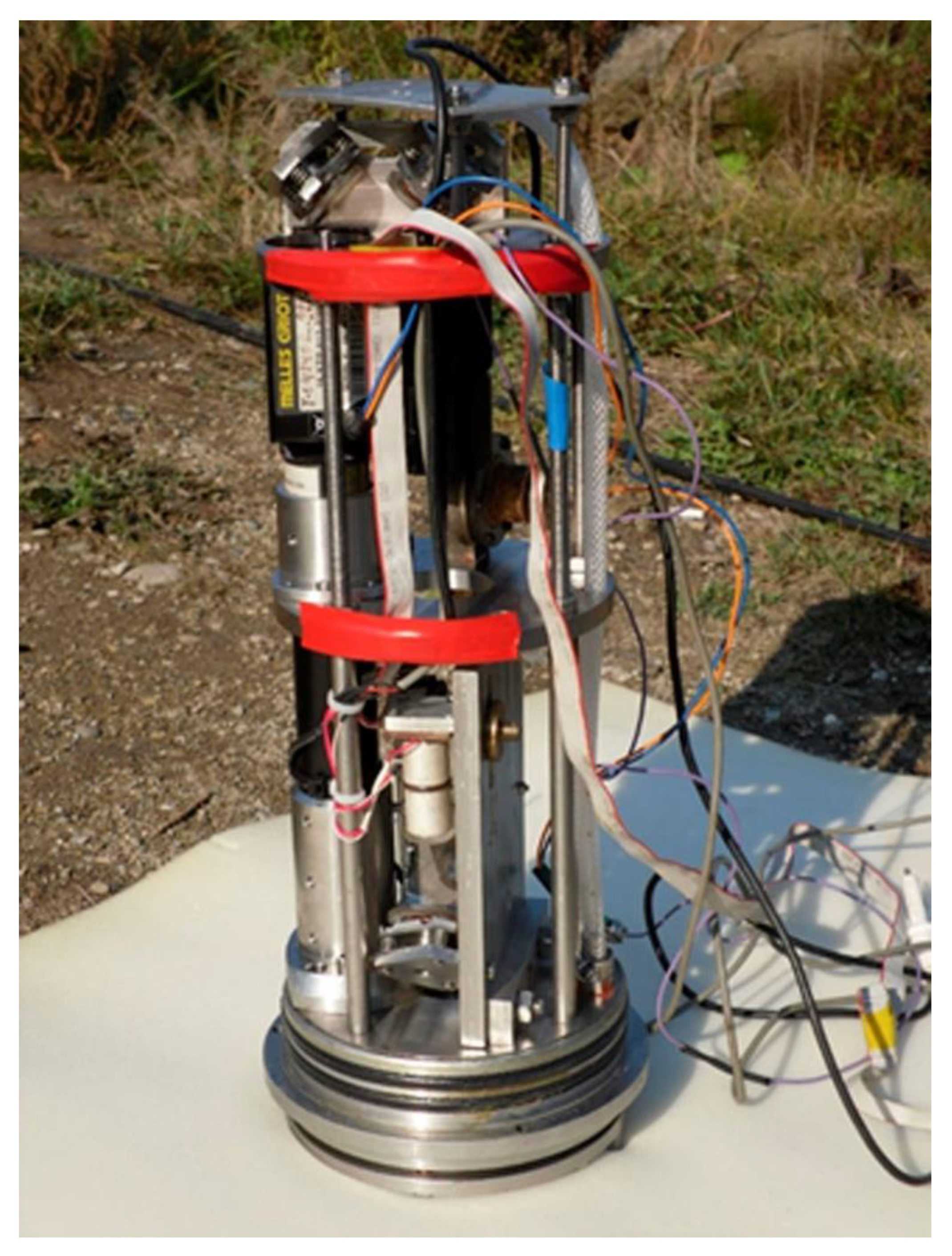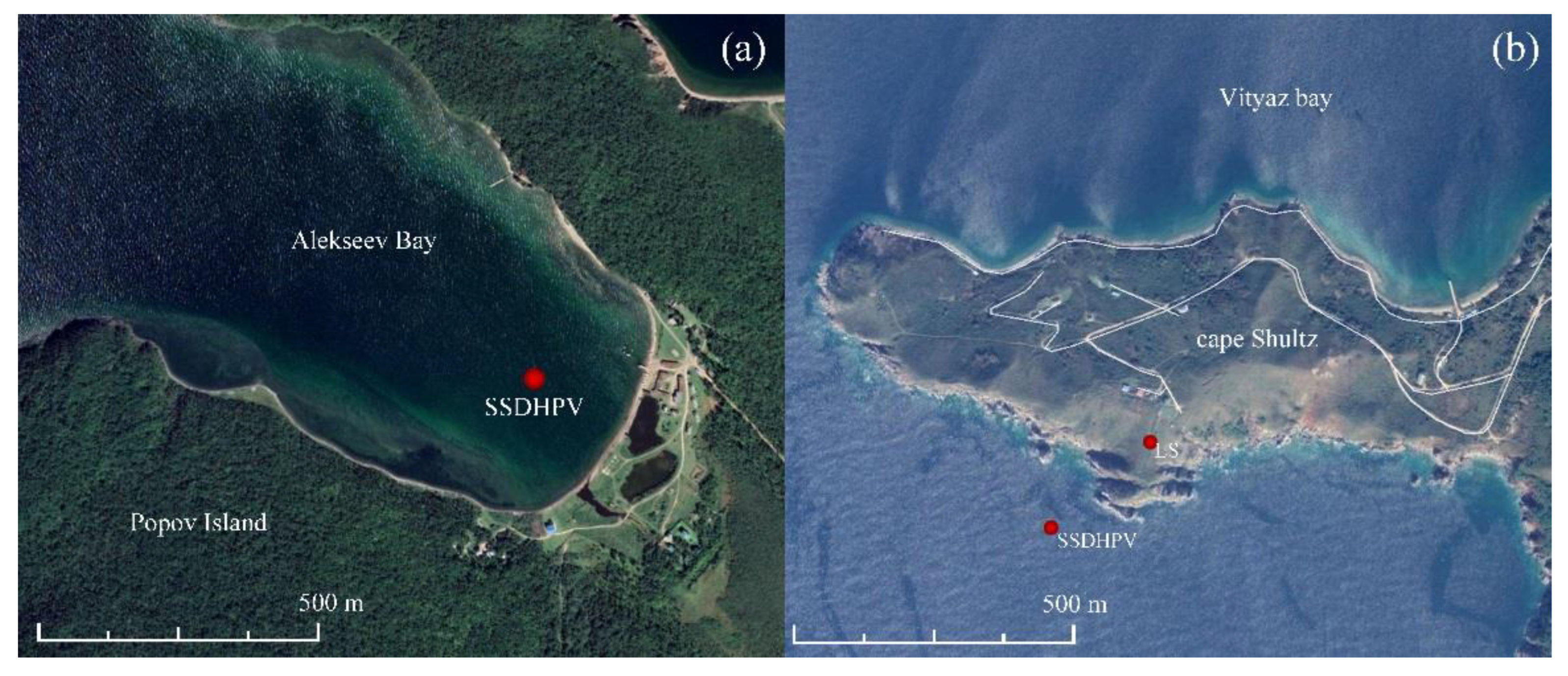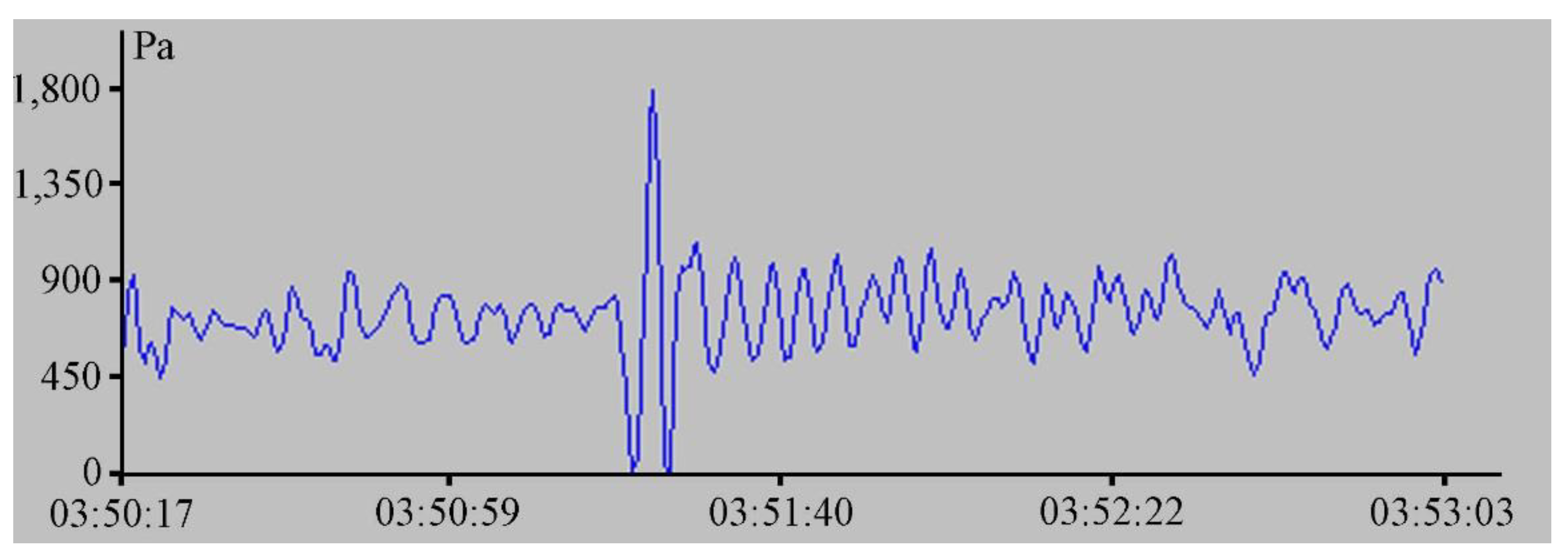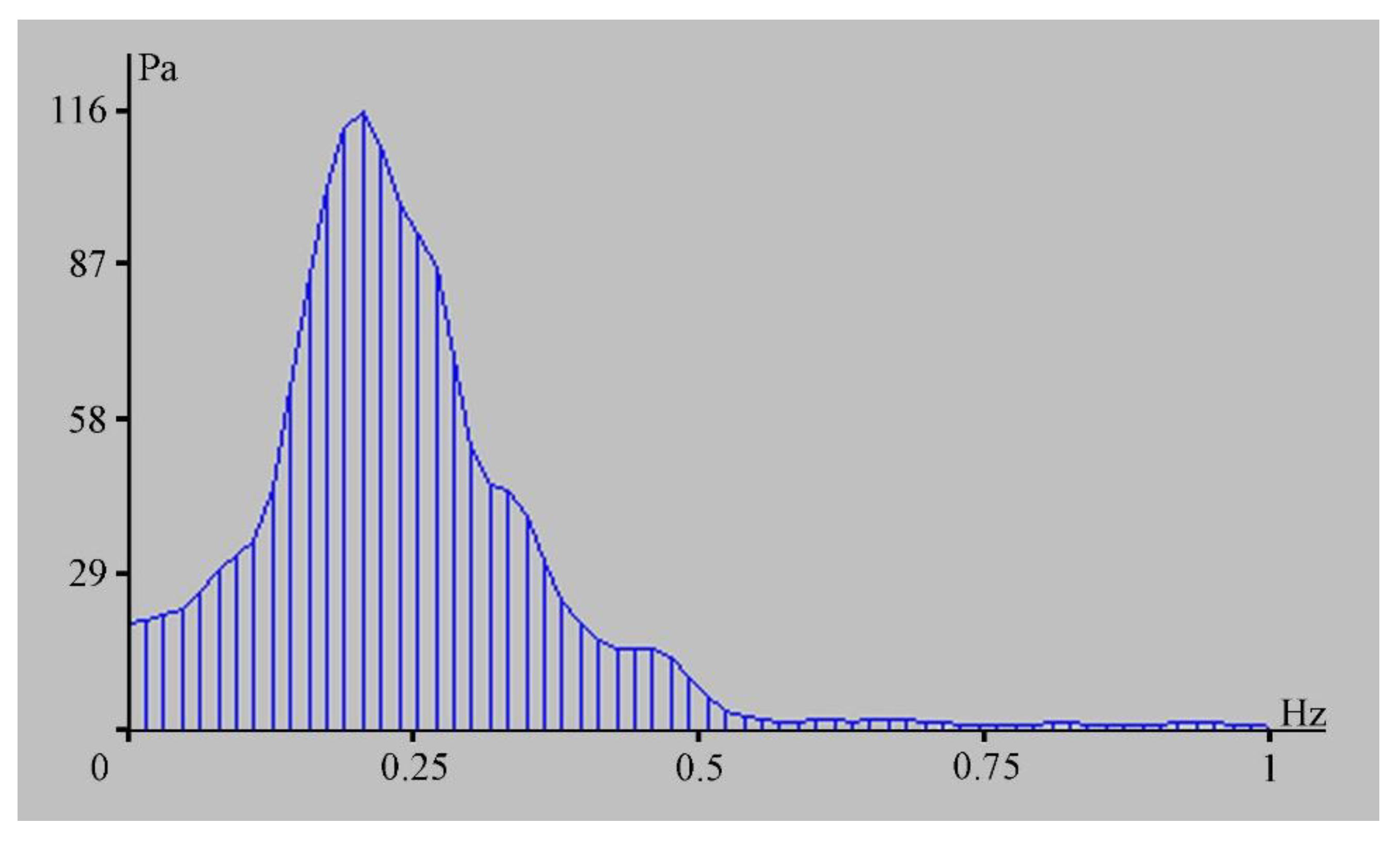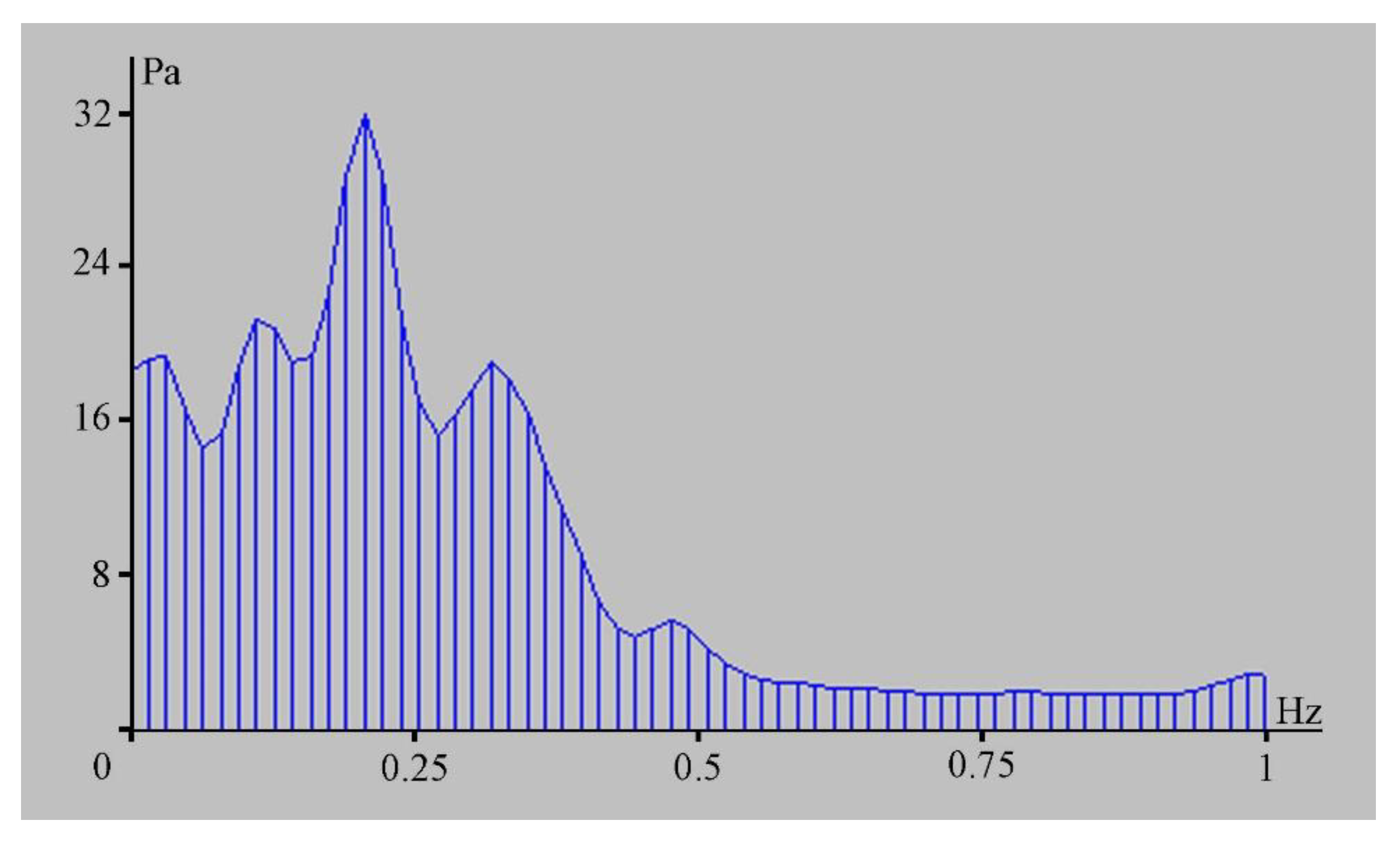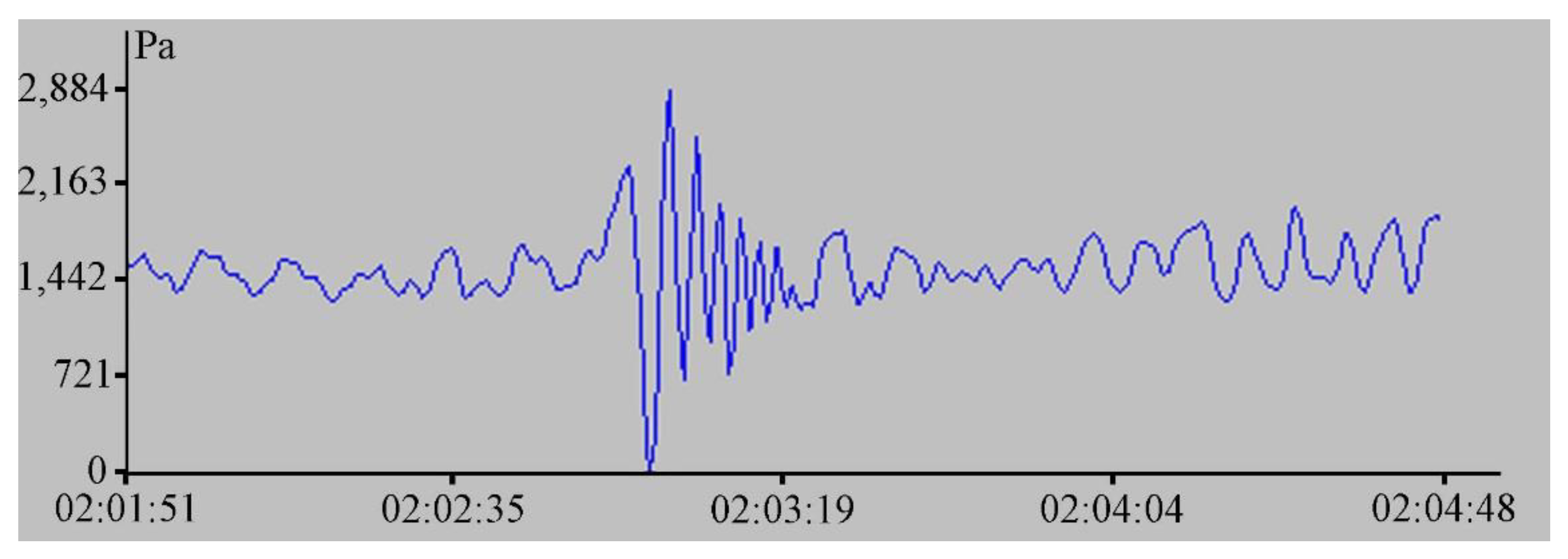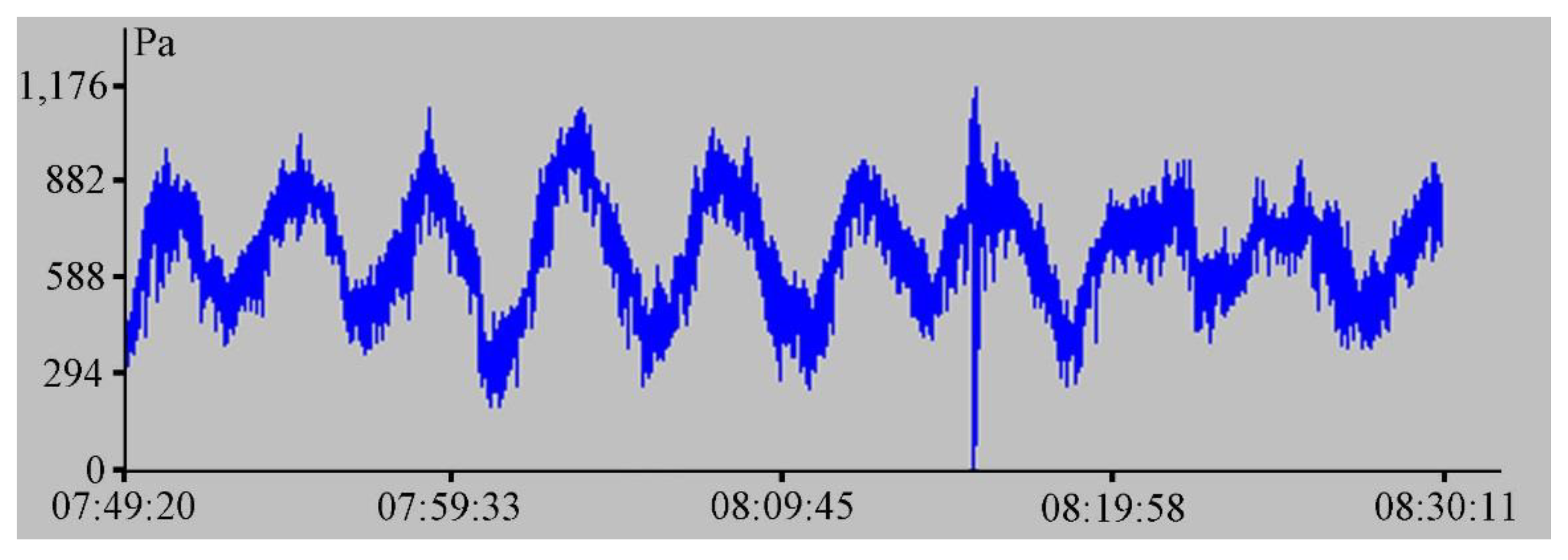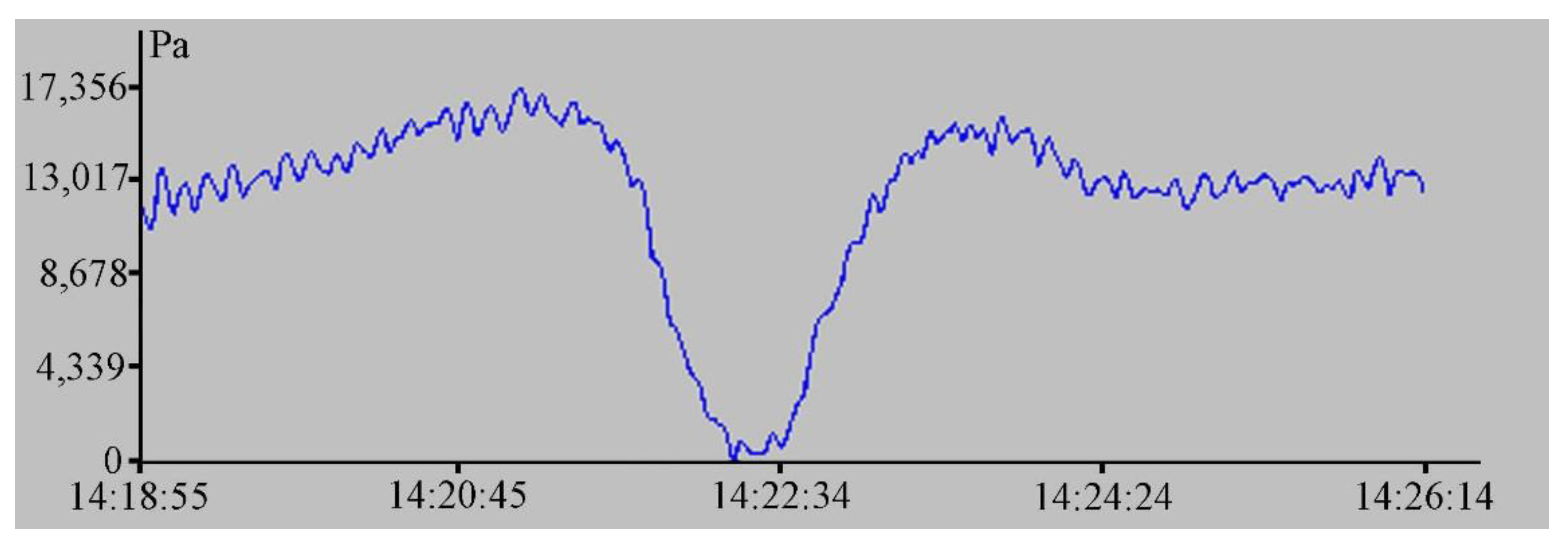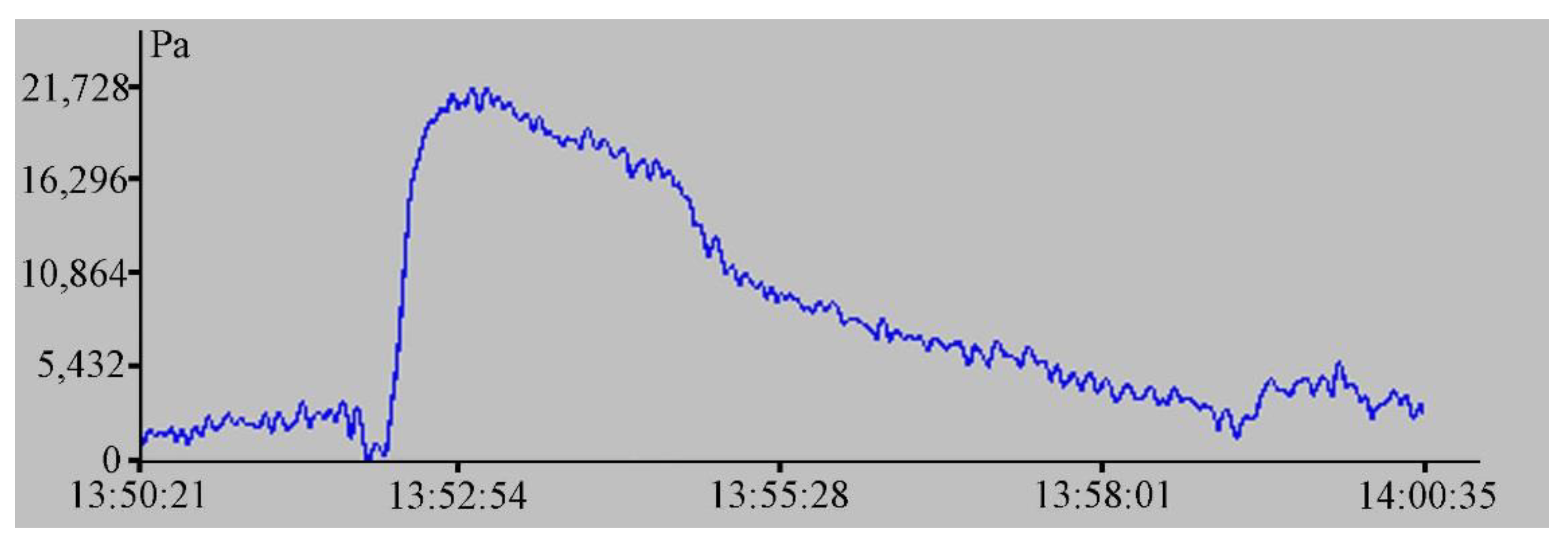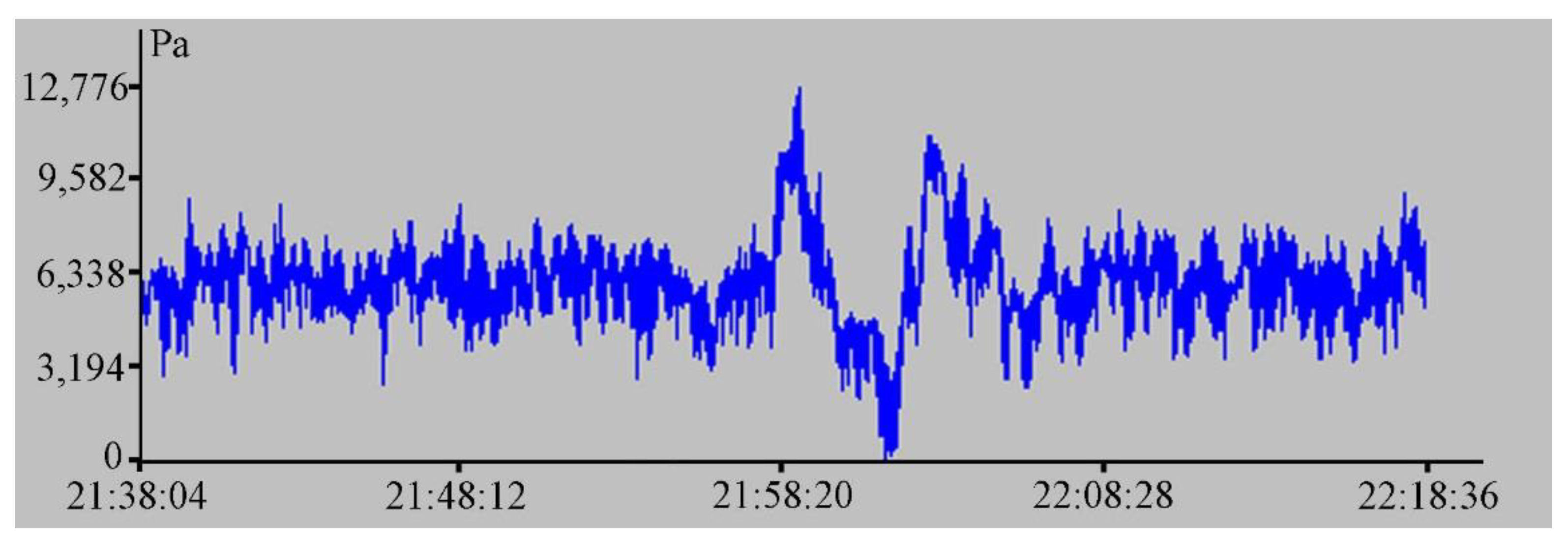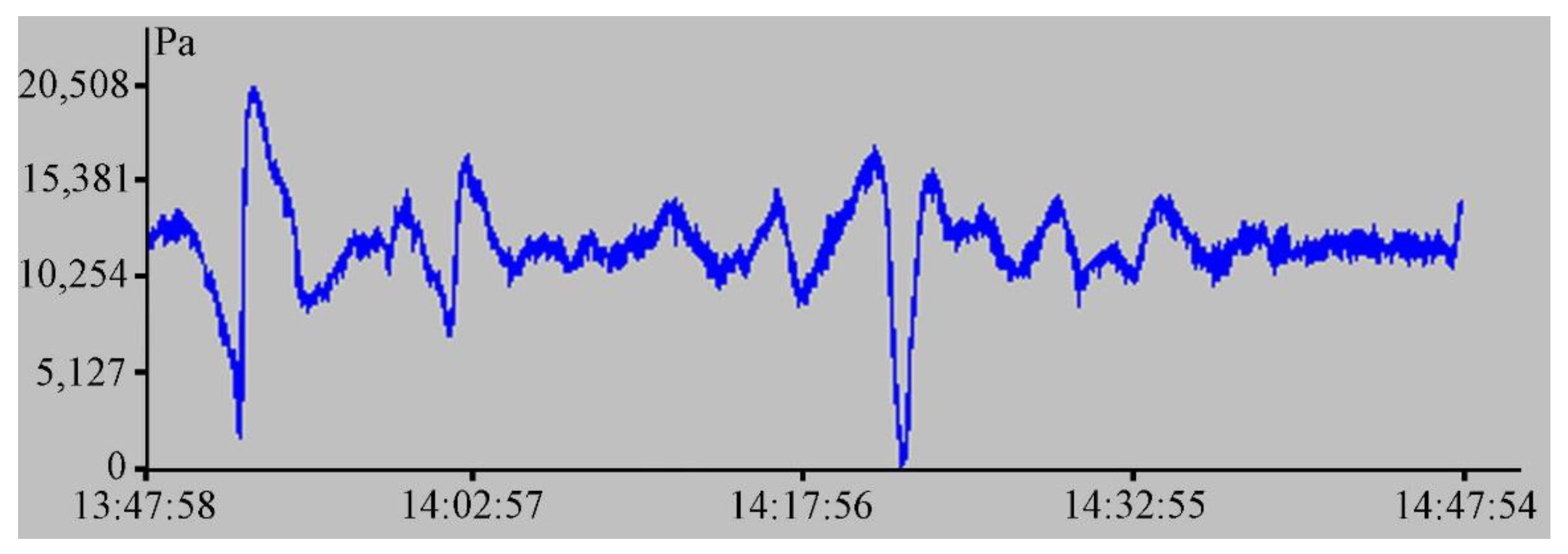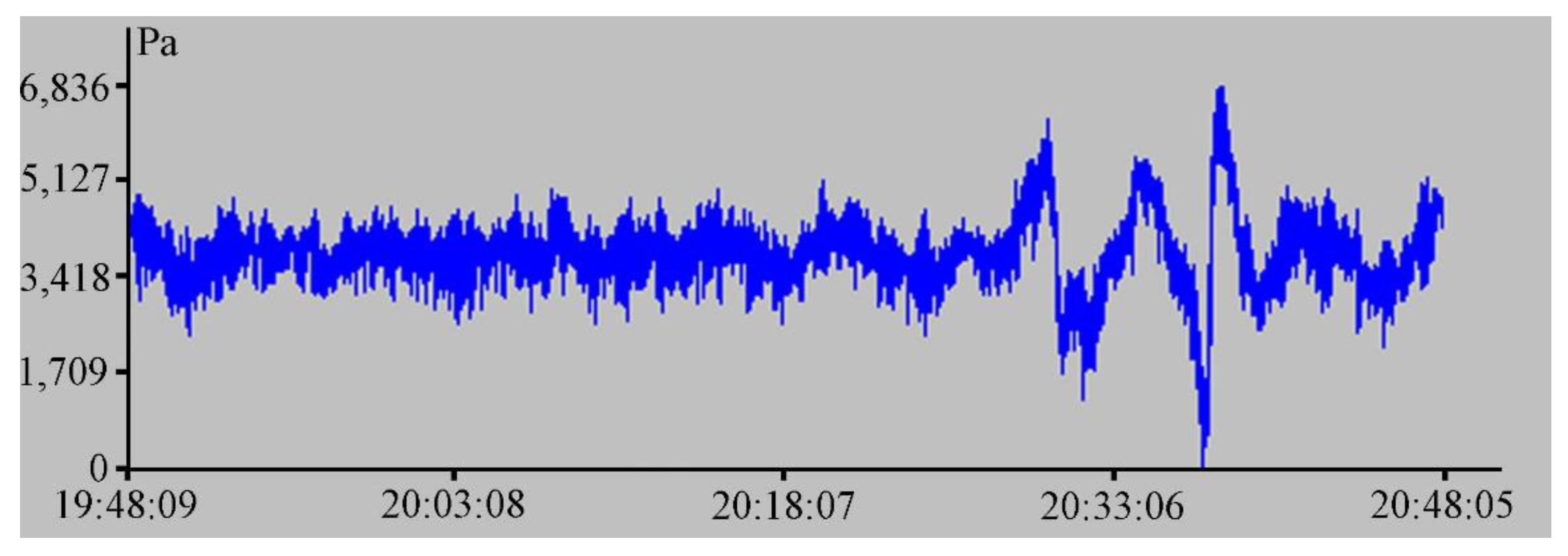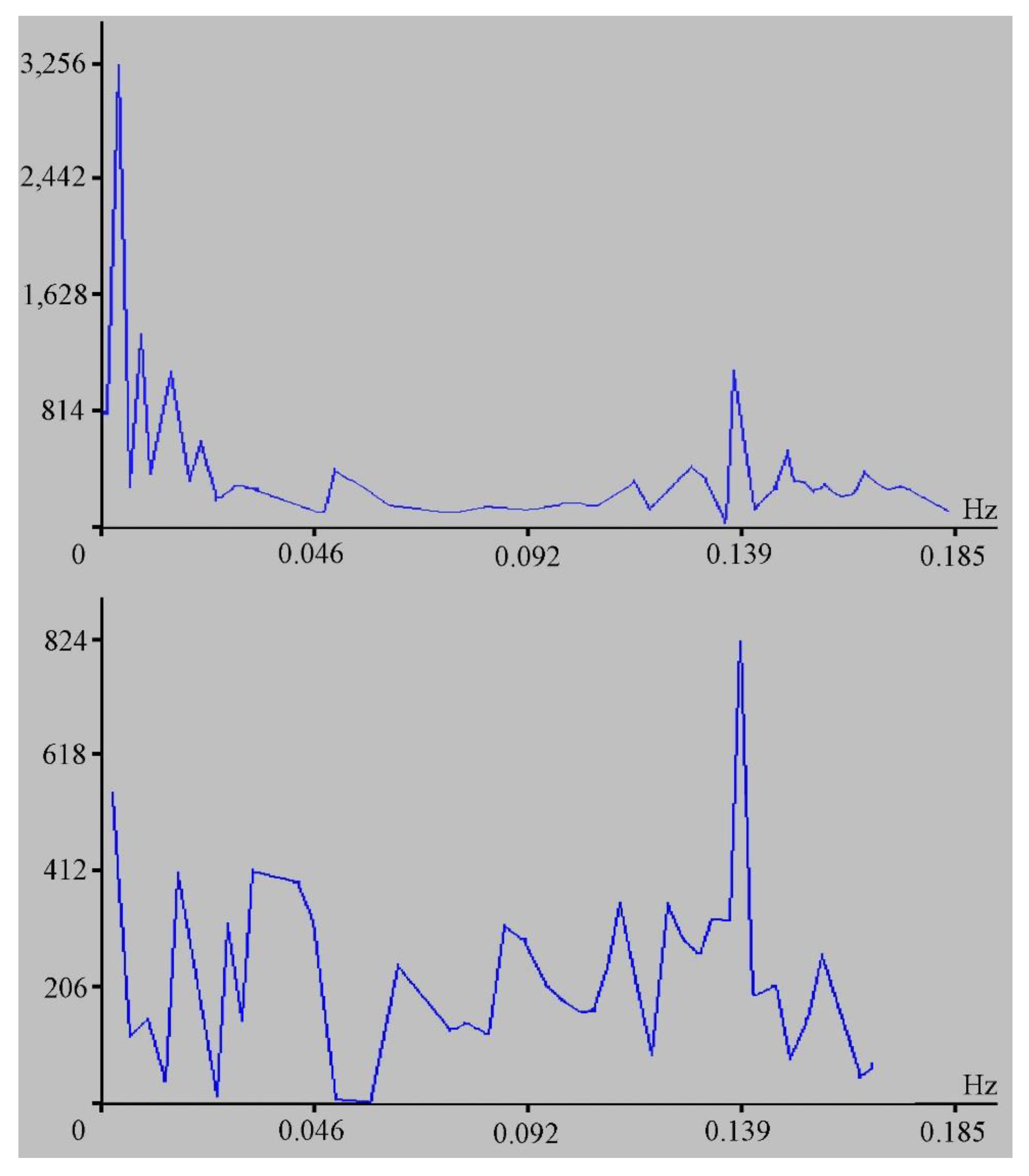1. Introduction
In the latest twenty or thirty years, many studies have been devoted to the experimental and theoretical aspects of the origin and development of the so-called rogue waves. Before these studies were published, such nonlinear sea formations were believed to be quite rare, and news on the sighting of rogue waves was comparable to news about sightings of the Loch Ness Monster; in subsequent years, according to [
1,
2,
3,
4], rogue waves appeared en masse, in practically not reasonably countable numbers. This situation makes us think about the correctness of identifying the formed anomalies as rogue waves. When sea gravity waves that are, for example, 10 m high, emerge, and at certain time intervals, a disturbance of the same period but 20 m high arises, we can subsume this disturbance to rogue waves, according to the criterion of twofold excess. There is every reason for this, but according to the above papers, these occurrences cannot be considered rare cases. Rather, we have to state that they are formed regularly. Such regularity greatly reduces interest in these nonlinear formations. In general, if we are talking about nonlinearity, we can see that there is almost no linearity in nature. All processes are nonlinear, and they become linear only in our approximation.
Let us now turn our attention to some experimental and model-theoretical results of rogue waves’ formation conditions.
Refs. [
1,
2] report that anomalous waves are formed in the same period as those of sea waves before and after so-called rogue waves. Wherein, it is considered that the maximum excess of the amplitude of a rogue wave should be 2.8 times greater than the amplitude of regular sea wind waves (gravity sea waves). A large review is presented in [
5]; it describes experimental results demonstrating a record of rogue waves with periods equal to those of wind waves. Theoretical studies aim to derive a mechanism of rogue wave formation. We should note that these works describe not rogue waves formed by the interaction of hydrophysical fields of different scales, but rogue waves that have emerged inside a single wave field consisting of wind waves. It is clear that for the formation of rogue waves in such a field, it is necessary to come up with mechanisms for concentrating (grouping) wave energy in a certain space-time area. When one looks at the spectrum of any wind wave, consisting of several almost-equivalent peaks, it becomes clear that to create a rogue wave, wave energy must be concentrated on one of these peaks, “leaking” from the other peaks. Near-similar experimental pictures are presented in [
6,
7,
8,
9,
10,
11,
12,
13,
14] and other studies. In all these works, a rogue wave is formed with the maximum directed upward, while in [
12], various rogue waves are described, the maxima of which are directed both up- and down-ward (“hole”). Nevertheless, the formed rogue waves are located within a single wave field.
A wide range of different approaches is used to develop the theoretical elements of the cited papers. When using the classical hydrodynamic equations, it is impossible to obtain formations such as rogue waves. In this case, only nonlinear methods of solving problems can help. One of the methods is dispersion focusing using the framework of the Korteweg–de Vries equation and wavefront reversal [
13,
14,
15], which allows the obtaining of a steep increase in wave energy at a certain point in space. The solution of the Korteweg–de Vries equation without the focusing effect and, especially, without wavefront reversal, would not lead to the obtained result, which, to some extent, adequately, describes the observed experimental results. Another approach is based on the application of the Schrodinger equation, but, again, with an additional mechanism, leading to the set goal—modulation instability [
16]. The instability of homogeneous waves in relation to sufficiently long disturbances develops as a result of quasi-resonant four-wave nonlinear interactions. This is the dominant type of wave of small and moderate steepness instability in deep water. At present, the effect of modulation instability of sea waves is considered a mechanism of the origin of large-amplitude waves, which increases their probability. Experimentally observed soliton-like rogue waves in this approximation are easily explained by breather solutions, which, in turn, can be interpreted as envelope solitons against the background of a homogeneous wave. At the same time, breather solutions are obtained by solving the sine-Gordon equation; they are also applicable to the description of the origin of the nonlinear deformation disturbances that serve as tsunami indicators [
17]. When describing mathematical rogue waves by the sine-Gordon equation [
18], we obtain two solutions in the form of periodic waves that have different properties of modulation instability [
19,
20].
The above cases relate to the origin of rogue waves in the conditions of one wave field—either wind waves or swell waves. But other cases are also possible. In cases where waves are captured by jet streams or extended seabed inhomogeneities, and in particular, by the sloping of the seabed in shallow water, waveguides with a modal transverse structure are formed. As a result, the dimensionality of the dynamic system effectively reduces, the nonlinear dynamics become close to the case of collinear waves, and much more favorable conditions for modulation instability are realized, which are unattainable under usual conditions [
21,
22]. The rapid evolution of the spectra and probabilistic characteristics of waves occur in different situations when the wave system becomes modulationally unstable or is subject to disturbance: when initial conditions are specified in the form of linear superposition of waves with a fairly narrow spectrum, during forced mixing of the waves’ phases; and when pumping is turned on or off, while simulating the effect of the wind. Similar behavior was observed with a rapid change in propagation conditions: currents or local depth. In addition, when swell waves interact with local wind waves, rogue waves, very different from those that originated within the same wave field, may emerge. According to [
23], in this case, rogue waves of the “one sister”, “two sisters”, “three sisters”, “four sisters”, etc. types emerge in a field of wind waves. In other words, when a field of wind waves interacts with a field of swell waves, characteristic rogue waves emerge. A natural question arises: do rogue waves emerge when a field of wind waves interacts with lower-frequency wave fields, or when a field of swell waves interacts with lower-frequency wave fields? In addition, the role of atmospheric processes in the generation of such hydrosphere disturbances is interesting, i.e., soliton-like signals, etc. In this paper, we will focus on this aspect when processing and analyzing the obtained field data.
It can be noted that when describing the physics of the occurrence of rogue waves, we mainly draw on theoretical studies, or, at best, on works with numerical experiments. This indicates that there are very few articles describing in situ data, and there is practically no qualitative in situ data, especially when rogue waves are formed as a result of the interaction of waves from different wave fields. The lack of high-quality field data has led to the fact that, in theoretical studies, the description of the physics of the occurrence of rogue waves is based on the application of various nonlinear equations and concepts (the sine-Gordon equation, the Korteweg–de Vries equation, the Schrodinger equation, etc.), which is completely wrong. The mechanism should be one equation or concept, and the physics of occurrence should be another. This article describes and interprets field data obtained using unique equipment with unique amplitude-frequency characteristics. In addition, during long-term observations with the use of this equipment, we found that the occurrence of rogue waves also depends on the regional characteristics of the shelf areas. Therefore, the placement of receiving equipment (a laser-based supersensitive detector of hydrosphere pressure variations) at the place of formation of multi-scale wave fields allowed us to obtain unique field data, which, we hope, will allow us to build working models of the formation of rogue waves.
2. Laser Interference Receiving Systems. Site. Data
For many years, a laser interference complex has been operating at Schultz Cape in the Peter the Great Bay of the Sea of Japan and the adjacent shelf. The complex consists of two laser strain meters of the classical type, with measuring arms of 52.5 and 17.5 m, oriented along the “North-South” and “West-East” lines, respectively [
24]; a laser nanobarograph [
25] and a laser-based supersensitive detector of hydrosphere pressure variations, the latter of which has recently has been modified to obtain better technical characteristics [
26]. All laser interference systems are based on Michelson interferometers of the equal-arm (the laser nanobarograph and the laser detector of hydrosphere pressure variations) and unequal-arm (the laser strain meters) types.
The main results of field studies were obtained by recording hydrosphere pressure variations at various points of the shelf, using the supersensitive detector of hydrosphere pressure variations.
Figure 1 shows the internal view of the supersensitive detector of hydrosphere pressure variations. It is based on a modified Michelson interferometer of the homodyne type and a frequency-stabilized helium-neon laser, which ensures the stability of the radiation frequency to the ninth decimal place. The interferometer is enclosed in a cylindrical stainless-steel housing, which is fastened in a protective grating, designed to protect the instrument in severe operating conditions (rocky or slimy seabed). One side has a hole for cable entry. The other side is hermetically sealed with a lid. In addition to the protective grating, an elastic air-filled container is located outside the instrument. Its outlet is connected with a tube to a compensation chamber, located in the removable cover. The housing contains a Michelson interferometer, a compensation chamber, an electromagnetic valve, and a digital recording system. The sensitive element of the supersensitive detector is a round membrane, which is fixed at the end face of the device. On the outside, the membrane interacts with water. On the inner side of the membrane, a mirror is fixed, which is a part of the “cat’s eye” system, consisting of a biconvex lens of the appropriate focal length, and this reflective mirror. The mirror with the lens is included in the structure of the measuring arm of the interferometer. The mirror, rigidly fixed in the center of the membrane, shifts along the interferometer axis under the influence of the hydrosphere pressure variations. A change in the length of the measuring arm leads to a change in the intensity of the interference pattern, recorded by the digital registration system. The output signals of the supersensitive detector, after preprocessing by the digital registration system, are the hydrosphere pressure variations. An in-built external pressure compensation system is used to keep the sensitive element (membrane) in a neutral position while the instrument is lowered to its operating depth. Balancing the external pressure and the pressure inside the chamber results in the membrane being set to the neutral position. This instrument installation scheme is used for any operating depth, and the membrane is always initially set to the neutral position.
The supersensitive detector of hydrosphere pressure variations has the following technical characteristics: operating range, 0 (conventionally)—1000 Hz, measuring accuracy of hydrosphere pressure variations, 0.24 mPa, and operating depth, up to 50 m.
For many years, the supersensitive detector of hydrosphere pressure variations was installed for different durations at different points of the shelf.
Figure 2 shows a map of the site indicating the location of the instrument. In all cases, the detector was installed on the seabed. The instrument operated autonomously in Alekseev Bay, Popov Island, while in other cases it was powered, and the obtained field data were transmitted along cables connecting the instrument operating on the seabed and the laboratory onshore building. After pre-processing, filtering, and decimation, the obtained field data were placed into a previously created field database.
3. Processing and Analysis of the Obtained Field Data
In the first part of this section, we will describe the anomalous signals, observed on the supersensitive detector of hydrosphere pressure variations, which, according to the features outlined in the introduction, can be considered rogue waves.
Figure 3 shows an example of a “classical” rogue wave in a field of wind waves, which was singled out from the record of the detector installed on the seabed at a depth of 4 m (Alekseev Bay). During spectral processing of the data before the disturbance, during the disturbance, and also after the disturbance, the most energy-bearing maxima were identified at periods of about 5 s, which correspond to the main period of wind waves in Alekseev Bay, Popov Island during the measurements. What peculiarities can we note in the observed record, shown in
Figure 3? The height of the observed anomalous signal is approximately three times greater than the heights of the signals before and after the disturbance. While before the appearance of the anomalous signal, we observe a usual pattern of wind waves with irregular signal amplitude from one wave train to another, immediately after the appearance of the anomalous signal, oscillations with a period equal to the main period of the wind waves with a slowly decaying amplitude are excited. Sometime after the disturbance, the usual pattern of wind waves’ behavior is restored. Immediately after the initiation of the anomalous signal, the energy is concentrated on the main wave mode. Wherein, in the times before and after the observed record, the energy slightly dissipates over the spectrum, redistributing itself between individual maxima.
Figure 4 shows the spectrum of the record prior to the anomalous signal.
Figure 5 shows the spectral record starting from the moment the anomalous signal occurs; and
Figure 6 shows the spectral record after the anomalous fragment, with a normal irregular pattern. As we can see from these figures, when an anomalous signal occurs, the energy is concentrated on one period. That is, the signal self-focuses. Before the anomalous event and after it, the energy “dissipates” over the spectrum. The following is interesting: The total energy of all harmonics (with a series length of 128 points and sampling frequency of 2 Hz) before the disturbance and after is approximately the same and is equal to about 630 relative units; with the same length of the processed disturbance, including the pulse of the rogue wave, it is approximately equal to 1570 relative units. Even without the solitary wave’s pulse, the total energy is approximately equal to 1060 relative units. From this comparison, it is clear that the solitary rogue wave was formed not only as a result of the self-focusing of gravity sea waves (wind wave field) but also as a result of the influx of external energy into the wind wave field. Considering that there are no other components in the spectrum of the disturbance, except for the main peak of the wind waves at 5 s, we can assume that the source of additional energy is in the atmosphere or the Earth’s crust (lithosphere, seabed). One such source may be earthquakes of small magnitude, generating oscillations of about 5 s in their focal point. Their dissipation in the Earth’s crust leads to an increase in the wind wave train with the self-focusing of energy on the main oscillation period. The process is close to the process of near-resonant excitation of a system with a certain quality factor with subsequent hyperbolic damping of the excited oscillations.
The mechanism of external energy occurrence in the microseismic range is described in [
27]. This work states that the formation of the largest spectral maximum in the microseismic range with a peak frequency in the range of 0.14–0.22 Hz (7.1–4.5 s) is associated with the low-frequency scattering of elastic wave energy in mountainous rocks. According to this mechanism, in a two-component medium, such as a rock (solid rock plus pore water), the energy of elastic waves is dissipated in the form of low-frequency pulses. The lower the porosity coefficient, the lower the pulse frequency. In this case, it is assumed that low-power seismic events are constantly occurring in the frequency range above 6 Hz, and their scattered energy serves as a source of low-frequency noise. The atmosphere, as the most dynamic environment among all geospheres, can be the external source of initiation of an anomalous signal in the water environment, by analogy with the processes, described in [
28,
29], but in its own frequency range. Taking into account the near-resonant behavior of the process, we can state that the external exciter was a pulse of appropriate duration (5 s).
Based on the above, especially from the values of the total energies of all harmonics of the considered sections of the recordings of the detector before the excitation section, the excitation section, and after the excitation section, it can be assumed that the process of formation of rogue waves is associated with external pumping in the near-resonance case. The case under consideration relates to the excitation of rogue waves in one field, i.e., in the field of wind waves. During the spectral processing of all the sections, we identified the main energy harmonics associated specifically with surface disturbance. Thus, the external exciting force should have natural frequencies close to the frequency of the main wind waves. The total energy of this external influence is almost 1.5 times greater (1570 − 630 = 940 relative units) than the total energy of the considered background areas of wind disturbance (630 relative units).
Another solitary wave, corresponding in amplitude to the rogue wave, identified from the record of the supersensitive detector of hydrosphere pressure variations, is shown in
Figure 7. The behavior of the disturbance is very different from the previous case. The excitation is of approximately the same duration, then there is rapid hyperbolic damping of the process with a successive decrease in the main oscillation period from 5 to 2 s. The behavior is similar to the non-isochronous behavior of a nonlinear system, in which the carrier frequency of oscillations increases with the decrease in the amplitude of oscillations. The total energy in this section of the recording (with a realization length of 64 and sampling frequency of 2 Hz) is approximately 2990 relative units, while the time before and after it is approximately equal to 320 relative units. It is clear that there was an external pumping of energy into this wave process. The water environment was excited, and the energy of this wave process at the frequency of the main period of the wind waves (5 s) was successively transformed into the energy of the main wave process of Alekseev Bay, with a period of 2 s. Taking into account the fact that there was no external feed (wind of corresponding acceleration) in this period of oscillations, the process of water mass oscillations in the period of 2 s quickly decayed. The oscillations period of 2 s is the main period of wind waves of local origin, i.e., wind waves, the origin of which is determined by the acceleration magnitude, other geometric characteristics of Alekseev Bay, and the direction and speed of the wind in the spring-autumn season.
When comparing the results shown in
Figure 3 and
Figure 7, general patterns can be identified. In both cases, the excitation of these nonlinear waves (rogue waves) is caused by an external influence, the energy of which significantly exceeds the energy of the considered sites. In the case shown in
Figure 7, it is almost 9.5 times greater than the energy of the background sections of the recordings. The main excitation occurs on the main mode of a wind disturbance. If, in the first case, the energy of the background wind wave of the open part of the Sea of Japan is significantly increased (5–6 s), then, in the second case, the energy of the background wind wave of Alekseev Bay is significantly increased, even though there are weak wind waves in the bay that came from outside the bay.
These nonlinear high-amplitude hydrophysical disturbances stand out against the background of seiches, surpassing them in amplitude. As an example,
Figure 8 shows a nonlinear hydrophysical disturbance of the rogue wave type against the background of the seiches of Alekseev Bay. Even compared to seiches, the amplitude of this disturbance is twice as large as the amplitude of the seiches, and 5–6 times that of wind waves.
We have considered solitary waves, which correspond in their characteristics to rogue waves of the wind wave field. Next, we will turn to anomalous nonlinear formations of a different origin.
Figure 9 shows a fragment of the supersensitive detector of hydrosphere pressure variations record in which a powerful nonlinear hydrosphere formation stands out, corresponding to a “hole” type rogue wave. Against the background of wind waves, the height of this nonlinear formation is significant; on the sea surface, its magnitude is about 1.5 m, with a duration of about 2 min. Near-similar pictures are described in [
12]. Most importantly, the question of the origin of these nonlinear disturbances (the rogue wave “sea pit”) is interesting. The main mechanism of excitation of this rogue wave “sea pit” is the effect of a corresponding atmospheric pulse, which causes a natural phenomenon in a bay—a meteotsunami [
30].
In addition to registering these nonlinear disturbances, the maximum of which is directed downward, the supersensitive detector registers nonlinear hydrosphere disturbances, the maximum of which are directed upward.
Figure 10 shows a fragment of the detector record where a bay-like nonlinear hydrophysical disturbance stands out, the maximum of which is directed upward. This nonlinear disturbance reached its maximum magnitude in 30–35 s and lasted for about 7 min. It is difficult to come up with a mechanism of occurrence of this disturbance in the water environment, other than the atmospheric, by analogy with the formation of meteorological tsunamis caused by the corresponding atmospheric processes [
30].
During further processing of the field data of the supersensitive detector of hydrosphere pressure variations, our attention was drawn to signals whose amplitude and shape differed greatly from the surrounding signals. The main differences were in the amplitudes and appearance of the recorded signals, which did not coincide in the frequency range with the background signals. Such background signals include sea waves that exist both before and after the observed anomalous signals. As a rule, the anomalous signals did not introduce any changes to the observed processes. For example, the periods and amplitudes of wind waves did not change in any way. And all the changes were due to both natural processes (for example, direction and speed of the wind) and physical processes, associated, for example, with dispersion laws, etc. As an example of anomalous signals of this type,
Figure 11 shows a fragment of the supersensitive detector of hydrosphere pressure variations record in which, against the background of existing wind waves, a signal that is very different in amplitude and shape from the surface waves stands out. The magnitude of this disturbance (from minimum to maximum) is about 1.3 m. The average marine tide in this area of the Sea of Japan is usually about 0.4 m. Thus, this anomalous disturbance is approximately three times larger than the tide. The duration of this disturbance is about 8 min.
When analyzing other records of the supersensitive detector against the background of surface wind waves, we identified several similar anomalous disturbances, different both in shape and amplitude.
Figure 12 shows another fragment of the detector record. The magnitude of this disturbance (from minimum to maximum) is about 0.67 m. This is, of course, a small magnitude, but quite noticeable against the background of a relatively calm sea.
In addition to such, mostly solitary, disturbances, group disturbances of a fairly large magnitude are observed.
Figure 13 shows a fragment of the detector record that shows several similar solitary disturbances. The magnitudes of these disturbances are quite large, but the largest of them is the first, equal to about 2.1 m. At the same time, the shape of this disturbance is asymmetric—the fall occurs for almost 3 min, and the rise is quite fast—about 21 s.
Figure 14 shows a fragment of the detector record, containing, by analogy with [
23], an anomalous hydrophysical disturbance of the “three sisters” rogue wave type.
Of interest is the question of the origin of these anomalous disturbances, especially those shown in
Figure 11,
Figure 12, and
Figure 14. Against the background of standard wind waves, they look alien. In [
23], they carried out numerical experiments that resulted in almost similar anomalous disturbances. In numerical experiments, it is assumed that swell waves propagate against the background of wind waves, caused by the action of the local wind. The wind is believed to be weak enough that anomalous swell waves are noticeable against this background. In numerical experiments, a random field of wind waves is set using the superposition of spectral components with random phases. Successive solutions allowed the reproduction of rogue waves in the field of wind waves (“one sister”, “two sisters”, “three sisters”, “four sisters”) the graphical representation of which is very similar to the graphs in
Figure 11,
Figure 12, and
Figure 14. Looking at
Figure 11,
Figure 12, and
Figure 14, we can say that they show typical rogue waves of the “two sisters” and “three sisters” types. What can we say about the wind waves, shown in
Figure 11,
Figure 12, and
Figure 14? The period of the wind waves is approximately 7 s. This period of wind waves is typical for almost all background swell waves in the Sea of Japan, which is approximately equal to 5–6 s. The physics of the occurrence of anomalous disturbances, described in [
23], is not applicable in our case, although our plots and those given in [
23] are very similar. Further, we will consider another physical process that can lead to the origin of such anomalous disturbances—rogue waves.
In order to study the regularities in the behavior of marine extreme surface disturbances, we analyzed several records of the supersensitive detector of hydrosphere pressure variations, similar to the records shown in
Figure 11,
Figure 12, and
Figure 14. In this case, we can note a common theme: the spectral components, obtained during the processing of the record fragment, containing anomalous signals, have pronounced maxima at two or three periods, one of which is in deep infrasonic range (a period of about 5 min), while the other is in the period of the wind waves. When processing fragments of the records, containing background signals, against which surface waves stand out, we have many maxima that spread over the spectrum in the infrasonic range (from 7 s to 5 min), and also the largest maximum, corresponding to wind waves. At the same time, all spectral maxima corresponding to wind waves (it would be more correct to say swells) in background fragments have significantly lower magnitudes than the same maxima for the record fragments containing anomalous disturbances. As a typical example, in
Figure 15 we present spectra, obtained from the spectral processing of fragments of the supersensitive detector record, using the maximum likelihood method. We processed the record fragments shown in
Figure 11. The record fragments shown in
Figure 12 and
Figure 14 were processed in the same way. Powerful peaks stood out in the deep infrasonic region at frequencies corresponding to periods in the range of 5–5.5 min.; and, in the range of swell waves, powerful maxima stood out in the range of 7–7.3 s. In the background fragments, the swell waves’ maxima were in the range of 6.7–7.8 s. This discrepancy in periods may be due to several reasons. The main reason is the different lengths of the selected record fragments (1024, 1616, and 1686 points), which results in different frequency resolutions. A second reason is associated with some dispersive and nonlinear processes, especially in the case of wind waves.
The main things to note for all the processed record fragments are the following: (1) For the background record fragments, the energy is “dissipated” over many spectral components; (2) For record fragments containing extreme surface disturbances, or, following [
23], rogue waves, the energy is concentrated within 2–3 spectral components; (3) The magnitudes of spectral maxima in the “rogue” case are always greater than the magnitudes of the spectral maxima in the “background” case. What is the physical mechanism for the occurrence of these anomalous disturbances?
With some approximation, this behavior is typical for the Fermi–Pasta–Ulam recurrence phenomenon with some modifications. Similar behavior of spectral components was observed upon excitation of geo-block oscillators [
31], but the process was more periodic. For various geo-block oscillators, the effects are united by one phenomenon, common for all processes—the Fermi–Pasta–Ulam recurrence phenomenon, which was first investigated by Fermi in numerical simulations of vibrations of a string, represented by 64 connected points. It is characteristic of any geo-block oscillator when excited by an external force. When the magnitude of the external force is greater than a certain threshold value for an oscillator, several modes are excited; their energy is distributed almost uniformly over neighboring frequencies. After some time, the pattern acquires its original form if dissipation processes are neglected. When the geo-block oscillator is supplied with energy of a magnitude lower than the threshold, single modes (one, two) are excited, between which the energy is transferred, i.e., the simplest act of the recurrence phenomenon occurs.
Our case is more complicated. Energy is transferred not between the modes of one wave packet, but between the modes of different wave packets, while the nature of their formation is different. One wave packet is responsible for the wind frequency range packet, and the second packet is responsible for the infragravity frequency range and is evidently associated with eigen oscillations of the water mass in the zone, where the supersensitive detector of hydrosphere pressure variations is located. Eigen oscillations of the water mass of the shelf area depend on its geometric dimensions. Under certain conditions, external energy feeding of the water mass occurs, which manifests itself in its short-term excitation with the concentration of external energy in one (rarely two) mode(s). At the same time, in a field of wind waves, we can observe rogue waves of the types described in [
23]: “one sister”, “two sisters”, and “three sisters”. The most energy-bearing during this excitation are the maxima, corresponding to the variations in the infragravity frequency range and the main maximum of the wind frequency range. We hope that further experimental and model-theoretical studies will research the physical mechanism of the observed processes.
4. Conclusions
While processing and analyzing the field data on hydrosphere pressure variations in a wide frequency range, which was obtained using a laser-based supersensitive detector of hydrosphere pressure variations, we found nonlinear hydrophysical disturbances relating, according to the main criteria, to the rogue waves. Based on the results of spectral processing and external features, three possible mechanisms of rogue-wave formation were identified: (1) as a result of the impact of an external pulse of atmospheric or lithospheric origin, the duration of which is equal to the period of the main maximum of the wind wave field and inter-mode self-focusing; (2) the loading effect of atmospheric nonlinear processes on the water surface of colossal pressure, leading to the formation of “hole” or “crest” rogue waves; (3) inter-mode interaction of the main modes of wind waves (swell waves, 7–7.3 s) and the main mode of regional infragravity sea waves (5–5.5 min). As a result of this nonlinear interaction, rogue waves such as of the so-called “one sister”, “two sisters”, and “three sisters” types are formed. An interesting question is the dependence of the occurrence of rogue waves on the periods of swell waves. It is possible that with a significant increase in the periods of wind waves, for example, up to 10–12 s, some other infragravity modes will be involved in the formation of rogue waves.
When comparing the total energy of all harmonics of sections of recordings of the same duration before the occurrence of a rogue wave, during a rogue wave, and after a rogue wave, the following patterns are established: (1) for a rogue wave occurring in a single wave field, the total harmonic energy of the recording section of the supersensitive detector of hydrosphere pressure variations is several times greater than the total harmonic energy of the recording sections of the same duration in the background observation period (absence of a rogue wave); (2) for rogue waves of the “two sisters” and “three sisters” types, arising from the interaction of different wave fields, such a pattern is not observed, and the energy of equal-duration sections is approximately the same.
During long-term experimental studies, the supersensitive detector of hydrosphere pressure variations was installed in various regions of the shelf of the Sea of Japan and various bays. But only when the detector is located near the south side of M. Schultz, were powerful infragravity waves with a period in the range of 5–5.5 min detected, which is associated with their regional origin. Therefore, the formation of rogue waves of the “two sisters” and “three sisters” types identified by us during the interaction of swell waves with infragravity sea waves is regional. Currently, a supersensitive detector of hydrosphere pressure variations is installed at this location to obtain long-term observation series in order to study the dynamic characteristics of registered nonlinear formations in the ranges of infragravity sea waves and swell waves. In the future, there is a plan to install a second supersensitive detector of hydrosphere pressure variations at some distance from the first detector in order to study the spatial changes of the selected rogue waves of the “two sisters” and “three sisters” types and determine the ratio of dispersion and nonlinearity in creating their shape. These studies are aimed at finding out the life expectancy of the formed rogue waves and their movement speeds.
